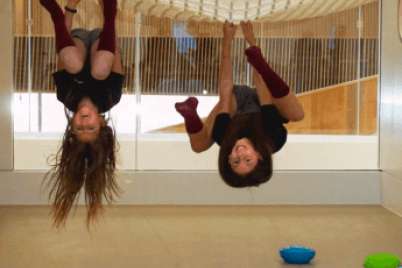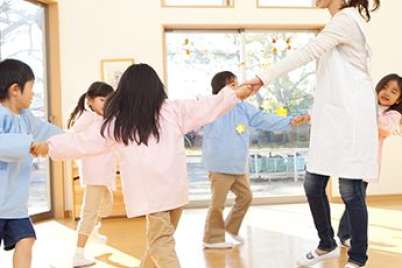
Early years educators and the challenges of physical literacy
Less than 10 years ago, the concept of physical literacy was virtually unknown in Canada. Now it’s included in education curriculum guidelines in many provinces, and it’s becoming part of preschool and early years programming in some areas. This is great news.
But there are challenges for educators as they implement physical literacy curricula in early years settings. Across Canada, preschool and early years educators face difficulties with suitability of play spaces, levels of staff training, and confidence around safety and liability.
A place to play
Donna Feeney is an early literacy specialist with Perth Care for Kids near Stratford, Ont. She has run physical literacy programs for children ages 18 months to three years in a variety of outreach locations, and she says the play space is sometimes a challenge.
“Depending on where they are, sometimes there might be pillars in the middle of the room, and some spaces might be a bit small to allow for free movement,” says Feeney. “However, we try to use outdoor space in parks when weather allows.”
Chelsea Ferris doesn’t find space to be a problem at Touchstone Academy, a private school for preschool to grade five in Saint John, N.B. As the school physical education teacher, she counts herself lucky to work with preschoolers inside an actual elementary school.
“We have a small gym space,” explains Ferris. “It’s not a typical gymnasium per se, but it’s a large empty space where we can bring the kids to do physical activity. If we only had a regular classroom, there wouldn’t be the physical space to do the activities they need to do. We also have a public garden in front of our building, so we are able to use that as our greenspace for running around and outdoor play.”
Preparation and planning
One of the keys to implementing physical literacy curricula is simply making time for it. Lindsay Jentzel, the executive director of the Banff Child Care Centre, is pleased to have enthusiastic educators who make physical literacy a part of their everyday planning.
“There are a lot of transitions during the day in a daycare situation,” explains Jentzel. “You’re having snack, and you’re doing bathroom, and these sorts of things. So you make the time to do a circle time and you incorporate a physical activity. It’s just planning for it and adding it.”
According to Jentzel, it doesn’t have to be complicated, either.
“A lot of times, you are doing physical literacy without realizing it,” says Jentzel. “You’re doing head and shoulders, singing a song, using your arms and your body, and some people don’t realize that this is also physical literacy.”
“We are lucky being in Banff because we have a forest, so you can do things like walk on the fallen trees to work on your core stability and balance,” Jentzel adds. “But we do have some equipment as well, so it’s just taking the time to bring those items into your room and doing a little preparation.”
Educator confidence and child safety
Another common challenge for early years educators is simply confidence. Even if they have been trained in how to lead physical activities with children, some educators who perceive themselves as “not sporty” may still feel unsure of themselves.
“I think it is a comfort thing as well and it often needs to be made a focus to make it more of a habit and a ritual of doing,” says Feeney. “I believe staff realize the importance of it but they need to be guided.”
The staff at Jentzel’s centre in Banff have all been trained to deliver the APPLE Seeds early years physical literacy curriculum that was developed at Mount Royal University in Calgary. But new employees at any centre will likely need time to get up to speed.
“Our staff have been given ample opportunity to learn about physical literacy, so they definitely feel confident,” says Jentzel, “but it could be a challenge if you had a new person coming in.”
Another part of confidence revolves around ensuring physical safety during activities.
“Because we have mixed age groupings of children from infants to four-year-olds, it can sometimes be problematic to find space for the older children to be active while keeping infants safe,” says Feeney.
“Another thing that could be a challenge is your group,” adds Jentzel. “If you have a group that tends to get too rambunctious when you do a physical activity, you need to figure out what is the best activity for them so it doesn’t get too wild within the classroom.”
Educators occasionally express concern about the physical capacities of the children in relation to some activities.
“I was just having a conversation with one of my educators the other day, and she was feeling insecure about the children using the stairs to go down the slide when they are still only crawling,” says Jentzel. “I told her that as long as she was doing everything she needed to be doing and she was supporting them, they might get bumps and bruises but they’re not going to seriously injure themselves. And besides — you don’t know — these children might have stairs at home that they use every day. They might actually be very competent on stairs and we just don’t know it yet.”
More support going forward
Going forward, everyone agrees that greater support is needed across Canada for early years physical literacy.
“It’s nice to see that physical literacy is starting to trickle down into the early years,” says Ferris, “but I think we still need more education, more resources, and more public support if kids are going to get what they should be getting at that age group.”
She is grateful to have found the APPLE Seeds curriculum resource, but there was otherwise a dearth of practical physical literacy resources for the preschool age group.
“It was hard to find curriculum for developing fundamental movement skills specifically aimed at that age group,” admits Ferris. “I kind of stumbled upon the APPLE Seeds program because I was looking for resources that really targeted that preschool age.”
The important factor is that educators such as Ferris, Feeney, and Jentzel see the importance of early years physical literacy.
“I feel that it is my responsibility to equip these kids with the skills that they need to be able to be active for life,” says Ferris. “If they don’t get it at home, then this is the only other place that they’re getting it from. That’s how I view my job — setting them up with the foundation they need to be active in whatever capacity they want later in life.”






It’s great to see people invested in promoting physical literacy to the preschool crowd. In Waterloo County, we have a dedicated position to assisting child care centres in developing their programs as well as assisting individual children who are experiencing difficulty with developing movement. As a Kinesiologist, I travel to child care centres and support the programs and children. We now have centres with amazing programs happening in them. Keep up the efforts, it’s worth it!